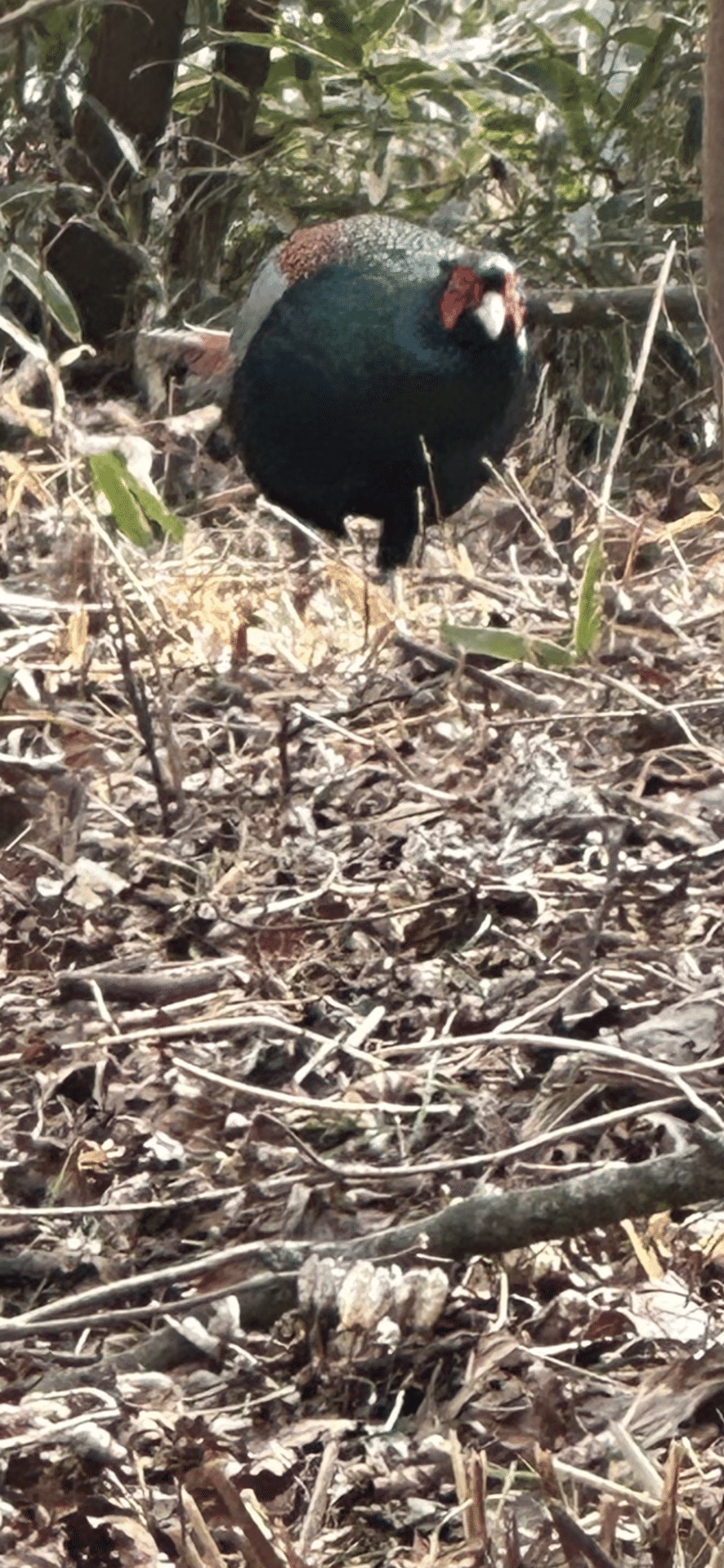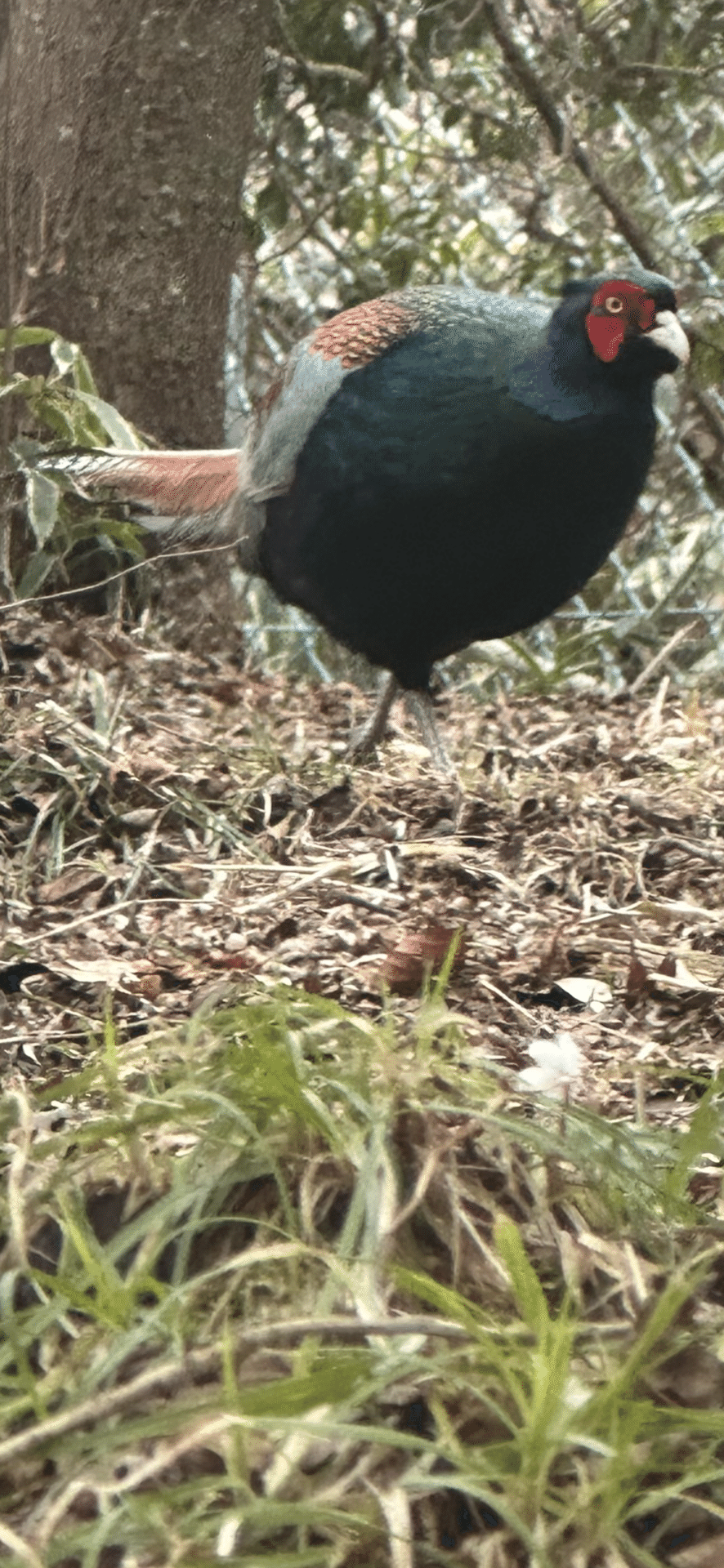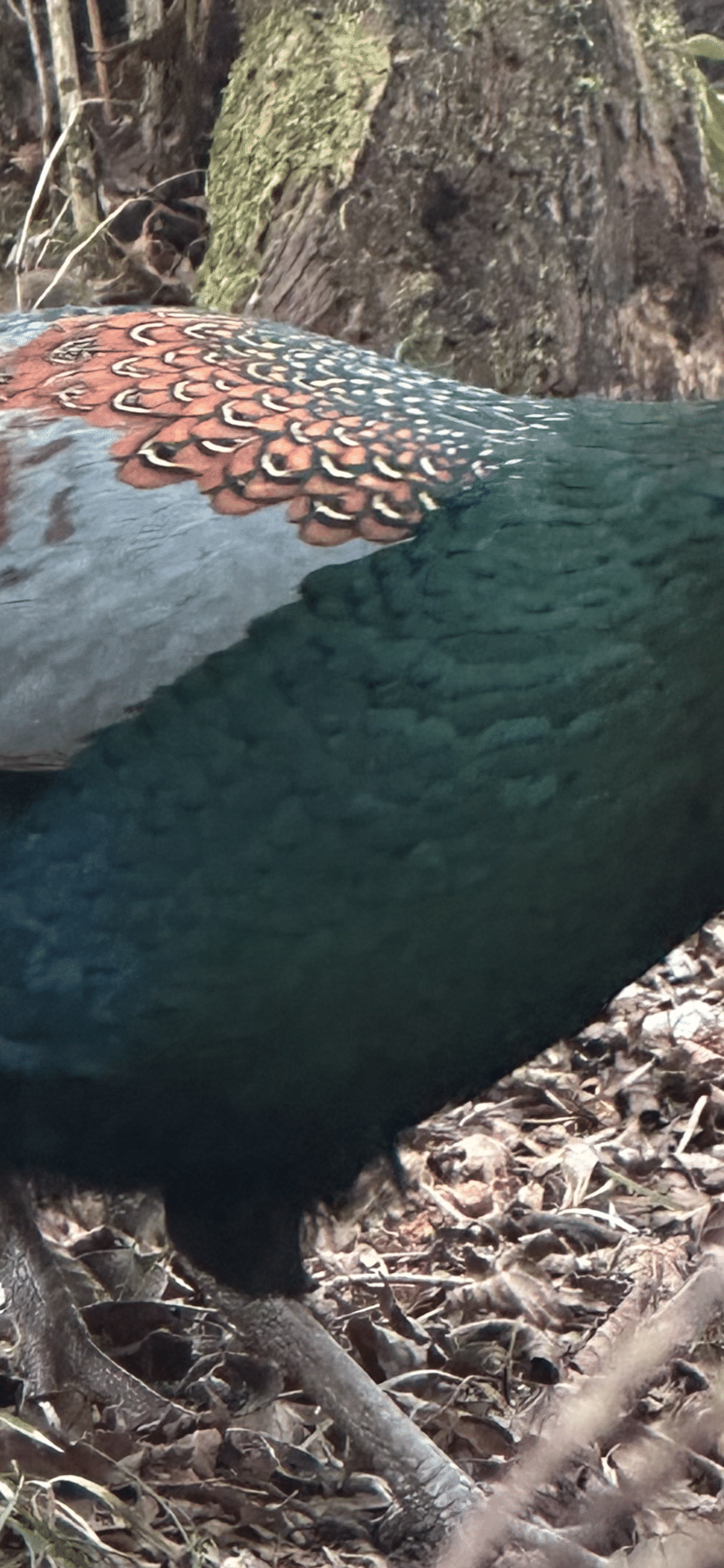
雉子
雉子 (キジ)
キジ目、キジ科、キジ属に分類される大型鳥類。
ユーラシア大陸の鳥類の亜種との説もあったが
現在では日本だけの固有種という結論に収まる。
そんな雉子と出会ったのは、六甲高山植物園の
中であり、梅花黄蓮(バイカオウレン)が群生
しているのを撮影している時に、視野の上の方
に何かが動くのを認識して、すぐ身を伏せた。
それがこの雉子であった。雉子のオスである。
メスはもっと地味な羽で全身を覆われている。
刺激しない様にして身を屈めたままIPHONEで
撮り始めた。それがこの写真となる。アップに
なるまでは10分程度を我慢した。背後からの
年配のご夫婦が大きな声で喋りながら来たのを
私は唇に指を当てて、『静かに、そこに居る』
のジェスチャーをすると、そのご夫婦はスロー
モーションの動きになって、私の指さす方向に
雉子の姿を確認してニンマリとして静かに写真
撮影に加わる。
動物園の檻の中のは見た事があるが、天然のは
初めてで何だかとっても得した気分になったの
である。
PHASIANUS
A large bird classified in the Phasianidae family under the Phasianinae subfamily and the Phasianus genus. While there were theories suggesting subspecies among birds in the Eurasian continent, the current consensus is that it is an endemic species found only in Japan.
I encountered that pheasant at the Rokko Alpine Botanical Garden while photographing the thriving clusters of Japanese kerria (Baikaouren). As I was capturing the scene, I noticed movement in my upper field of vision and immediately lowered myself to the ground.
It was a male pheasant. The females have more subdued feathers covering their entire bodies. Careful not to startle it, I bent down and began taking photos with my iPhone. This became the picture you see. I endured about 10 minutes until I could get a close-up shot. An elderly couple approached from behind, chatting loudly. I put a finger to my lips and gestured, "Quiet, there's one over there." The couple transitioned into slow-motion, confirming the pheasant's presence in the direction I pointed, and with smiles, they quietly joined in taking photos.
I've seen animals in zoo enclosures before, but this was my first time seeing them in their natural habitat, and it made me feel somehow enriched.








昔から『雉子も鳴かずば撃たれまい』なる諺が
ある。これは長野県に語り継がれている昔話から
くる言葉である。雉子繋がりなので懐かしいこの
話をここに載せておこうと思う。
雉子も鳴かずば撃たれまい
長野県の中央部を流れている犀川(サイカワ)の
ほとりに小さな村の群落があり、秋の台風時期に
なると毎年氾濫を起こしていた。少女の千代の母
も先の洪水の時に犠牲となり、父親の弥平と二人
で暮らしておった。
その千代が病に伏せてしまう。そんな千代が以前
一度だけ食べて美味しかった赤飯(小豆まんま)
を食べたいと云う。当時は高級品であった小豆を
貧乏な身分では買えない弥平は、地主の蔵の中に
忍び込むと、そこから米と小豆を盗み出して娘の
千代に食べさせたのである。千代はそれから元気
を取り戻して、父の弥平が畑仕事をしている時に
『あずきまんまを食べた』と手毬唄にして歌って
しまったのである。
その晩から秋の長雨となり、洪水を防ぐ為に誰か
人柱を立てる事となる。その人柱の人選には咎人
(トガビト、犯罪を犯した者)をそれに当てよう
となり、千代が歌った『あずきまんま』の手毬唄
を聞いた村人の証言から、地主の蔵中から盗みを
働いた事が父親の弥平の仕業と判明して、役人に
捕まり、犀川のほとりに人柱として埋められる。
千代はオイオイと泣き続け、泣き枯れてしまうと
言葉を忘れたかの様に一言も言葉を発しない者に
なってしまう。
何年もの年月が経って、猟師が雉子が鳴いたのを
猟銃で狙って撃つ。雉子が落ちた辺りへと猟師が
向かうと、そこに雉子を抱き抱えた千代が立って
おり、『雉子よ、お前も鳴かなければこんな風に
撃たれないで済んだものを』と呟くのであった。
千代自身が手毬唄で歌わねば父の弥平は死なずに
済んだのに、と手に抱えた雉子にそれを准えての
千代の言葉であり、その日以来、誰もこの千代を
見かける者はいなかったと云う。
口は災いの元、不謹慎に何でも口にするものでは
なく、それによって思わぬ災いを招く事があると
の教えを説いたものである。
There has been an old proverb, "Kiji mo nakazuba utaremai," which translates to "A pheasant that does not cry out will not be shot." This saying originates from a folk tale passed down in Nagano Prefecture. Given the connection to the pheasant, I thought it would be nostalgic to share this story here.
If the pheasant doesn't cry out, it won't be shot.
There is a small village community along the Sai River (Saikawa) flowing through the central part of Nagano Prefecture. Every autumn during the typhoon season, the river would flood regularly. Chiyo's mother had also fallen victim to a previous flood, and she lived with her father Yahē.
That evening, heavy autumn rains began, and in order to prevent flooding, it was decided to erect a human pillar. For the selection of the human pillar, they chose a culprit (togabito, someone who had committed a crime). Based on villagers' testimonies after hearing Chiyo sing the Temari Uta of "Azuki Manma," it was revealed that Chiyo's father, Yahē, had stolen from the landlord's storehouse. He was apprehended by authorities and buried as a human pillar along the banks of the Sai River.
Chiyo continued crying with a "Oi, oi" until she cried herself dry, and then, as if forgetting words, she became someone who didn't utter a single word.
After many years had passed, a hunter aimed and shot at a pheasant that had cried out. As the hunter approached the fallen pheasant, there stood Chiyo, holding the bird and murmuring, "Oh, pheasant, if only you hadn't cried out, you could have avoided being shot like this."
"If Chiyo had sung the Temari Uta herself, her father Yahē would have survived without dying," she said, pointing this out to the pheasant she held in her hands. Since that day, no one had seen Chiyo again.
Mouths can be the source of trouble. It is a teaching that cautions against speaking carelessly and consuming anything, as it may lead to unforeseen calamities.
和名 雉子 (キジ)
雉 (キジ)
洋名 ジャパニーズ フォエアサント
(JAPANESE PHEASANT)
学名 ファシアナス ヴァーシカラー
(PHASIANUS VERSICOLOR)
分類 キジ目、キジ科、キジ属
種類 大型鳥類
全長 オス 80cm
メス 60cm
全体 オス 派手(写真通り)
メス 地味(ウズラ風)
分布 日本(本州、四国、九州)
食性 植物の芽、葉、実
小型の虫類
鳴声 オス ケーン
メス ホロホロ
撮影 六甲高山植物園
■■■■■■■■■■■■■■■■■■■■■■■■■■
#キジ
#雉子
#雉
#ジャパニーズフォエアサント
#JAPANESEPHEASANT
#ファシアナスヴァーシカラー
#PHASIANUSVERSICOLOR
■■■■■■■■■■■■■■■■■■■■■■■■■■
